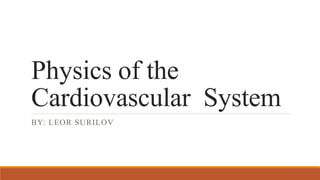
Physics of Circulatory Systems
- 1. Physics of the Cardiovascular System BY: LEOR SURILOV
- 2. Table of Content •Cardiovascular System: Physiology •Why is this Important? •How is this Related to Physics? •Conclusion
- 3. Cardiovascular System: Introduction to Physiology •The cardiovascular system consists of the heart, blood vessels that is responsible for the movement of the approximately 5 Liters of blood in the body •The systems primary role is for the transportation of oxygen, nutrients, hormones, and cellular waste throughout the body Retrieved from: https://classconnection.s3.amazonaws.com/820/flashcar ds/1256820/png/pulmonary_circuit1334640245694.png
- 4. Cardiovascular System: Physiology of Blood • Blood is a complex mixture involving: • Plasma (liquid component) – roughly 55-60% of the blood’s volume • Red blood cells – roughly 40% of the blood’s volume • White blood cells – important for the immune system • Platelets – important for blood clotting •Red blood cells is an important component in blood because it carries oxygen from the lungs and delivers it to all body tissues •Oxygen is vital to produce energy and produces carbon dioxide as waste product that is diffused out of the lungs
- 5. Cardiovascular System: Physiology of Heart •The heart is a fist-sized muscular organ that is in the centre of the chest •The only function is to pump blood •The heart has four chambers: • Right and Left atrium (upper chamber), which is used for collecting blood • Right and Left ventricles (lower chamber), which is is used for pumping out blood •Four valves are present within the heart to ensure the blood flows in only one direction: the ventricles has inlet and outlet valves • The heart allows blood to be oxygenated after it returns to the heart and remove deoxygenated and carbon dioxide via lungs Retrieved from: http://www.nottingham.ac.uk/nursing/practice/res ources/cardiology/images/heart_diagram.gif
- 6. Cardiovascular System: Physiology of Blood Vessels •The blood vessels are the pipes of the body •They consist of arteries, arterioles, venules, veins, and capillaries •Blood is delivered throughout the body using these vessels •The diameter of the blood vessels changes from the moment it leaves the heart (arteries) to when it returns to the heart (veins) •Blood vessels are muscular vessels that can dilate and constrict blood to increase or decrease blod flow Retrieved from: http://antranik.org/wp-content/uploads/2011/12/blood-vessel-anatomy-between- arteries-capillaries-and-veins.jpg
- 7. Why is this Important? •About 610,000 people die of heart disease in the United States every year–that’s 1 in every 4 deaths. •Every year about 735,000 Americans have a heart attack. Of these, 525,000 are a first heart attack and 210,000 happen in people who have already had a heart attack. •Leading causes of death •Understanding the connection between flow characteristics and the development of cardiovascular disease (atherosclerosis, thrombosis) and improving and developing methods to reduce deaths Retrieved from: http://www.cdc.gov/nchs/fastats/leading-causes-of-death.htm
- 8. How is this Related to Physics? •The cardiovascular system can be seen as the pressure system the body •There are multiple ways physics can play a role in the cardiovascular system: • Influence of gravity • Fluid flow down pressure gradient • Velocity of flow • Work of the heart (can be viewed as a simple pump) • Turbulent Flow • Viscosity
- 9. How Is this Related to Physics: Energetics of Flowing Blood •An important concept is that kinetic energy and potential energy must remain unchanged throughout system •This concept is called the Conservation of Continuity, where the energy of fluid in a vessel is constant 𝑚𝑎𝑠𝑠 𝑓𝑙𝑜𝑤𝑖𝑛𝑔 𝑖𝑛 = 𝑚𝑎𝑠𝑠 𝑓𝑙𝑜𝑤𝑖𝑛𝑔 𝑜𝑢𝑡 𝐴1 𝑣1 = 𝐴2 𝑣2 = 𝑄 = 𝑉𝑜𝑙𝑢𝑚𝑒 𝑡𝑖𝑚𝑒 = 𝑐𝑜𝑛𝑠𝑡𝑎𝑛𝑡 Q= flow rate A= Area v = velocity
- 10. How Is this Related to Physics: Energetics of Flowing Blood •Within the circulatory system is successive Y-junctions with vessels of the same diameter of smaller diameters (arteries vs arterioles). •The conservation of mass can help determine the flow speed of different diameters of vessels Retrieved from: http://legacy.owensboro.kctcs.edu/gcaplan/anat2/notes/I mage356.gif Retrieved from: https://fluidmechanics77.files.wordpress.com/2014/05/21.png
- 11. How Is this Related to Physics: Energetics of Flowing Blood •The Conservation of Energy is the basis of Bernoulli’s Principle or Equation •The equation states that an increase in the speed of a fluid flow will result in a decrease in the pressure •This is important in the cardiovascular diseases such as atherosclerosis (plaques of fatty material causing narrowing of the vessel) 𝑃1 𝑝𝑟𝑒𝑠𝑠𝑢𝑟𝑒 𝑒𝑛𝑒𝑟𝑔𝑦 + 1 2 𝜌𝑣1 2 𝐾𝑖𝑛𝑒𝑡𝑖𝑐 𝐸𝑛𝑒𝑟𝑔𝑦 + 𝜌𝑔ℎ1 𝑃𝑜𝑡𝑒𝑛𝑡𝑖𝑎𝑙 𝐸𝑛𝑒𝑟𝑔𝑦 = 𝑃2 + 1 2 𝜌𝑣2 2 + 𝜌𝑔ℎ2 Retrieved from: http://www.memorialcardiology.org/wp- content/uploads/2013/01/diseased-artery-atherosclerosis-colorado-springs.jpg Retrieved from: http://www.cvphysiology.com/Hemodynamics/H012%20Bernoulli.gif
- 12. Conclusions •Cardiovascular system components are the blood, heart, and blood vessels •The heart’s main function is to pump blood around the body • The blood vessels diameter changes after it is pumped out of the heart arteries •Physics is highly connected with the physiology of the heart and could assist in solving how to reduce the leading cause of death in the world •Conservation of Continuity and Bernoulli’s Principle help calculate and understand blood flow •Conservation of Continuity states that energy throughout the pipe must be maintained •Bernoulli’s Principle states that an increase in velocity means a decrease in pressure and vice versa
- 13. References •Bernoulli's Principle and Energetics of Flowing Blood. (n.d.). Retrieved July 01, 2016, from http://www.cvphysiology.com/Hemodynamics/H012.htmBrown, T. A. (2012). Rapid review physiology. Philadelphia, PA: Mosby/Elsevier •Heart Disease Facts. (2015). Retrieved July 01, 2016, from http://www.cdc.gov/heartdisease/facts.htm •Hollins, M. (1990). Medical physics. Macmillan. •MCAT Physics Review Notes. (2010). New York, NY: Kaplan.
